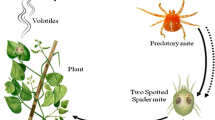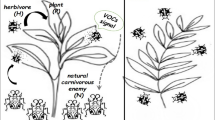Abstract
Plant population response to herbivore attack by releasing volatile organic compounds (VOCs) in a highly regulated fashion. The natural enemies of herbivores are attracted by such induced volatile. This type of mechanism is known as “indirect defense mechanism” for plants. A tritrophic interaction among the plants, herbivores and their carnivorous enemies is considered along with “indirect defense mechanism” of plants in recruitment rate of carnivorous enemies. A systematic analysis of the dynamics of plant–herbivore–carnivore system with Holling type II functional response is done in this paper. The conditions for existence and feasibility of boundary and interior equilibrium points of the system are also determined. The conditions for the global stability of positive equilibrium point is derived. Persistence of the system is studied. Here, different types of bifurcations are analyzed with respect to many parameters. A key role is played by immigration rate of carnivores in determining the eventual state of the ecosystem. Finally, numerical simulations are performed to validate the obtained results.





Similar content being viewed by others
References
Arimura, G., Kost, C., Boland, W.: Herbivore-induced, indirect plant defences. Biochim. Biophys. Acta (BBA) Mol. Cell. Biol. Lipids 1734(2), 91–111 (2005)
Birkhoff, G., Rota, G.: Ordinary Differential Equations. Ginn, Boston (1989)
Bryant, J.P., Chapin, III, F.S., Klein, D.R.: Carbon/nutrient balance of boreal plants in relation to vertebrate herbivory. Oikos pp 357–368 (1983)
Bryant, J.P., Swihart, R.K., Reichardt, P., Newton, L.: Biogeography of woody plant chemical defense against snowshoe hare browsing: comparison of Alaska and Eastern North America. Oikos pp 385–395 (1994)
Coley, P.D., Bryant, J.P., Chapin, F.S.: Resource availability and plant antiherbivore defense. Science 230(4728), 895–899 (1985)
DeAngelis, D.L.: Dynamics of Nutrient Cycling and Food Webs, vol. 9. Springer, New York (2012)
Dicke, M.: Local and systemic production of volatile herbivore-induced terpenoids: their role in plant-carnivore mutualism. J. Plant Physiol. 143(4–5), 465–472 (1994)
Dicke, M.: Evolution of Induced Indirect Defense of Plants. The Ecology and Evolution of Inducible Defenses, pp 62–88 (1999)
Dicke, M., Sabelis, M.W.: How plants obtain predatory mites as bodyguards. Netherl. J. Zool. 38(2), 148–165 (1987)
Fergola, P., Wang, W.: On the influences of defensive volatiles of plants in tritrophic interactions. J. Biol. Syst. 19(02), 345–363 (2011)
Freedman, H., Waltman, P.: Persistence in models of three interacting predator-prey populations. Math. Biosci. 68(2), 213–231 (1984)
Heil, M.: Indirect defence via tritrophic interactions. New Phytol. 178(1), 41–61 (2008)
Hilker, M., Meiners, T.: Early herbivore alert: insect eggs induce plant defense. J. Chem. Ecol. 32(7), 1379–1397 (2006)
Holling, C.S.: The components of predation as revealed by a study of small-mammal predation of the european pine sawfly. Can. Entomol. 91(5), 293–320 (1959a)
Holling, C.S.: Some characteristics of simple types of predation and parasitism. Can. Entomol. 91(7), 385–398 (1959b)
Lamberti, G., Feminella, J., Resh, V.: Herbivory and intraspecific competition in a stream caddisfly population. Oecologia 73(1), 75–81 (1987)
Liu, Y., Zeng, R., Liu, D., Luo, S., Wu, H., An, M.: Modelling dynamics of plant defence volatiles using the an-liu-Johnson–Lovett model. Allelopathy J. 18(2), 215 (2006)
Liu, Y.H., Li Liu, D., An, M., Fu, Y.L., Zeng, R.S., Luo, S.M., Wu, H., Pratley, J.: Modelling tritrophic interactions mediated by induced defence volatiles. Ecol. Modell. 220(23), 3241–3247 (2009)
Lotka, A.J.: Elements of physical biology. Science Progress in the Twentieth Century (1919–1933) 21(82), 341–343 (1926)
Mithöfer, A., Boland, W.: Plant defense against herbivores: chemical aspects. Ann. Rev. Plant Biol. 63, 431–450 (2012)
Mithöfer, A., Wanner, G., Boland, W.: Effects of feeding spodoptera littoralis on lima bean leaves. II. Continuous mechanical wounding resembling insect feeding is sufficient to elicit herbivory-related volatile emission. Plant Physiol. 137(3), 1160–1168 (2005)
Mondal, R., Kesh, D., Mukherjee, D.: Influence of competition in modelling dynamics of plant defense with induced volatile. Model. Earth Syst. Environ. 4(3), 1197–1211 (2018)
Mukherjee, D.: The effect of prey refuges on a three species food chain model. Differ. Equ. Dyn. Syst. 22(4), 413–426 (2014)
Paré, P.W., Tumlinson, J.H.: Plant volatiles as a defense against insect herbivores. Plant Physiol. 121(2), 325–332 (1999)
Perko, L.: Differential Equations and Dynamical Systems, vol. 7. Springer, New York (2013)
Price, P.W., Bouton, C.E., Gross, P., McPheron, B.A., Thompson, J.N., Weis, A.E.: Interactions among three trophic levels: influence of plants on interactions between insect herbivores and natural enemies. Ann. Rev. Ecol. Syst. 11(1), 41–65 (1980)
Rosenthal, G.A., Berenbaum, M.R.: Herbivores: Their Interactions with Secondary Plant Metabolites: Ecological and Evolutionary Processes, vol. 2. Academic Press, Cambridge (2012)
Takabayashi, J., Dicke, M.: Plantcarnivore mutualism through herbivore-induced carnivore attractants. Trends Plant Sci. 1(4), 109–113 (1996)
Tollsten, L., Mller, P.: Volatile organic compounds emitted from beech leaves. Phytochemistry 43(4), 759–762 (1996)
Villalba, J., Provenza, F., Bryant, J.: Consequences of the interaction between nutrients and plant secondary metabolites on herbivore selectivity: benefits or detriments for plants? Oikos 97, 282–292 (2002)
Volterra, V.: Variations and fluctuations of the number of individuals in animal species living together. Anim. Ecol. pp 409–448 (1926)
Acknowledgements
This research of Ritwika Mondal was supported by DST/INSPIRE Fellowship/ 2015/ IF 150747. The authors are grateful to the anonymous reviewers for their helpful comments in improving this paper.
Author information
Authors and Affiliations
Corresponding author
Additional information
Publisher's Note
Springer Nature remains neutral with regard to jurisdictional claims in published maps and institutional affiliations.
Rights and permissions
About this article
Cite this article
Mondal, R., Kesh, D. & Mukherjee, D. Role of Induced Volatile Emission Modelling Tritrophic Interaction. Differ Equ Dyn Syst 30, 749–765 (2022). https://doi.org/10.1007/s12591-019-00458-y
Published:
Issue Date:
DOI: https://doi.org/10.1007/s12591-019-00458-y




